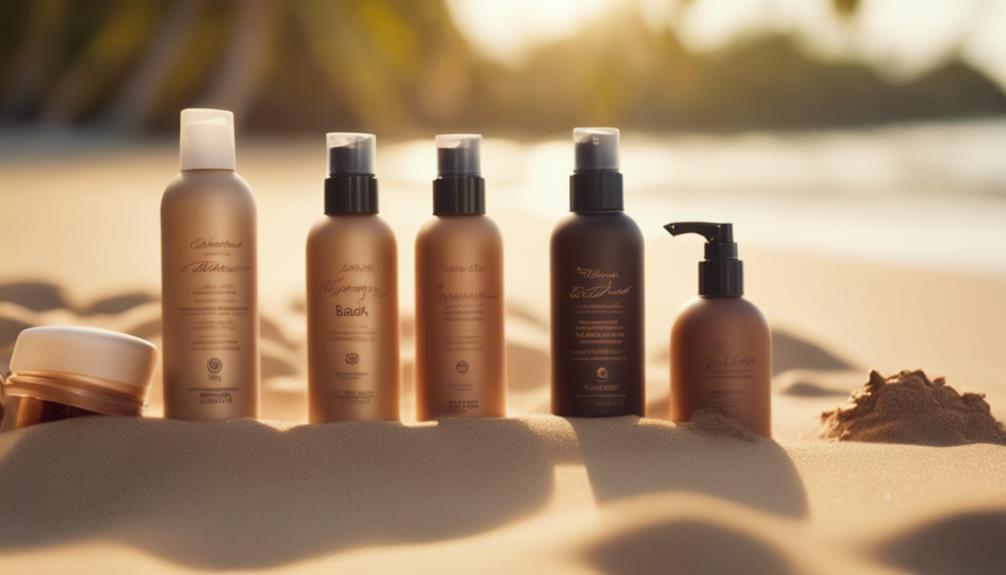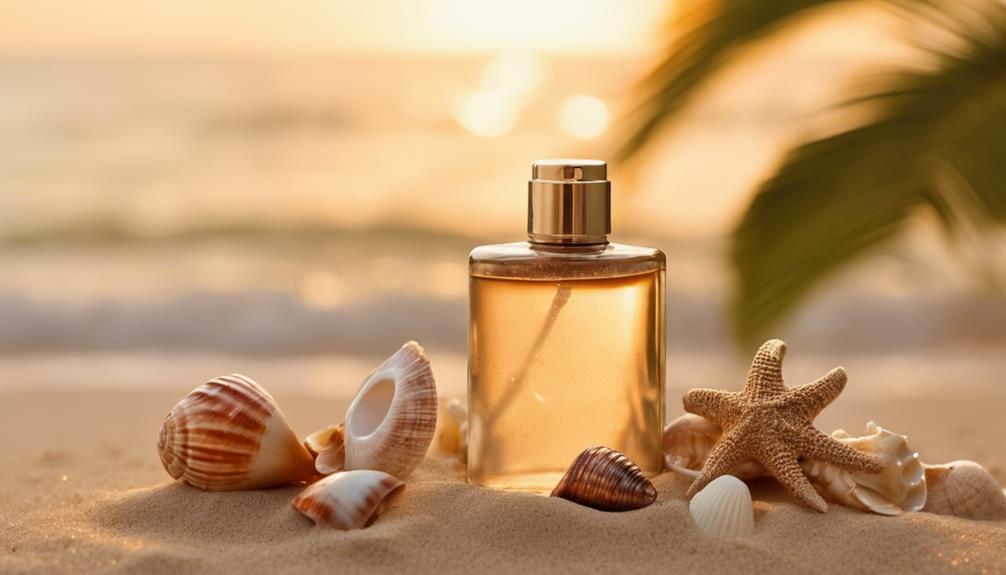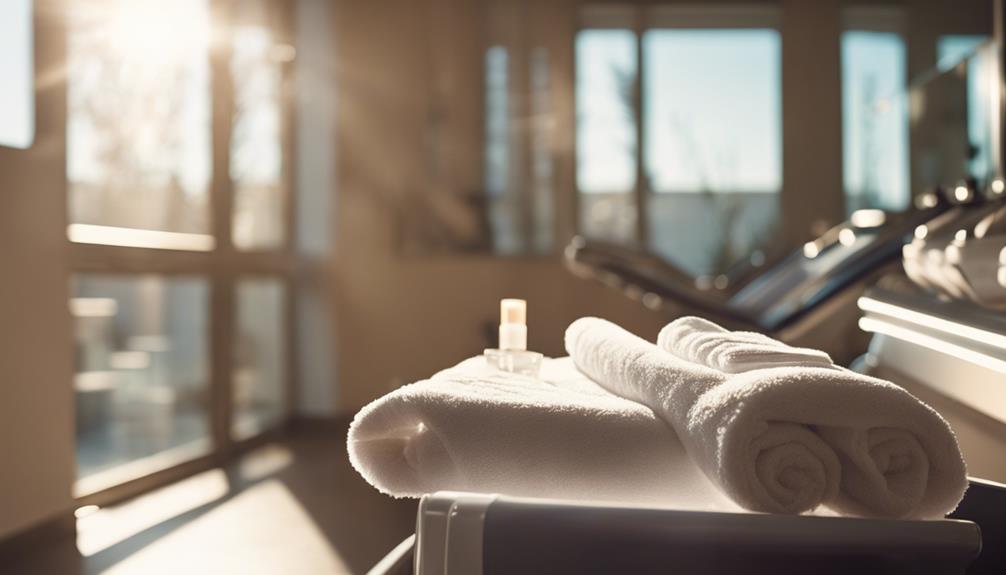Bronzer lotions are leading a safer tanning trend, providing a natural glow without the risks linked to UV exposure. These lotions are formulated with active ingredients like psoralen and tyrosine, which help speed up tanning while nourishing the skin. Proper application methods, such as exfoliation and blending, ensure a consistent and flawless finish. Unlike tanning beds, bronzer lotions offer immediate color and support skin health without harmful radiation. Selecting the correct product for your skin type and ensuring safe application can improve outcomes. Knowing these factors better highlights the advantages and tricks for achieving the perfect tan.
Key Takeaways
- Bronzer lotions provide immediate color without harmful UV exposure, making them a safer alternative to traditional tanning methods.
- Active ingredients in bronzer lotions enhance tanning while nourishing skin, promoting health and moisture retention.
- They are cost-effective compared to multiple tanning bed sessions while delivering a natural-looking tan.
- Proper skin preparation, including exfoliation and moisturizing, maximizes bronzer effectiveness and prolongs tan longevity.
Benefits of Bronzer Lotions
Bronzer lotions consistently offer a safer and more efficient alternative to traditional tanning methods, enabling users to achieve a natural-looking tan without the harmful effects of UV exposure.
These formulations typically contain active ingredients such as psoralen and tyrosine, which accelerate the tanning process within moments, eliminating the need for prolonged sun or tanning bed exposure.
Additionally, high-quality bronzer lotions are enriched with nourishing properties that not only enhance the resulting tan but also improve overall skin health, addressing signs of aging.
The moisturizing attributes of these lotions guarantee longer-lasting tans while providing a pleasant fragrance, enhancing the overall user experience.
Specific bronzer lotions are also available to maintain and prolong the tan, maximizing the benefits of this innovative tanning solution.
Application Techniques
Achieving an even and natural-looking tan requires careful application techniques that maximize the effectiveness of bronzer lotions. To guarantee ideal results, follow these essential steps:
- Exfoliate: Prior to application, gently exfoliate your skin to remove dead skin cells. This promotes an even surface for bronzer absorption and helps avoid patchiness.
- Apply Evenly: Use circular motions to apply the lotion, guaranteeing uniform coverage. Pay special attention to areas like elbows, knees, and ankles, applying less product to these spots to prevent dark patches.
- Blend Thoroughly: Carefully blend the lotion around the hairline and jawline to create a seamless shift.
Allow the bronzer to dry completely before dressing to avoid staining clothing and achieve a flawless finish.
Comparing Tanning Methods

A thorough comparison of tanning methods reveals distinct advantages and disadvantages between bronzer lotions and traditional tanning beds, particularly regarding safety, convenience, and overall skin health.
Tanning beds utilize UV exposure to achieve a deeper tan, but they carry considerable risks, including increased chances of skin cancer and premature aging.
Conversely, bronzer lotions provide an immediate tan without harmful UV radiation, markedly enhancing skin health through moisturizing properties. They are also more cost-effective, eliminating the need for multiple tanning sessions.
While the depth of color from tanning beds may be more pronounced, bronzer lotions enable individuals to achieve a natural-looking tan quickly and safely, aligning with modern preferences for healthier tanning alternatives.
Skin Preparation Steps
Effective skin preparation is essential for maximizing the results of bronzer lotions and ensuring an even, long-lasting tan. Following a proper regimen will enhance the effectiveness of the product and contribute to a beautiful, radiant complexion.
Here are three key steps to take into account:
- Exfoliation: Gently exfoliate the skin to remove dead cells, promoting a smooth surface for even application of the bronzer lotion.
- Moisturizing: Apply a nourishing moisturizer to hydrate the skin, which not only improves texture but also extends the longevity of the tan.
- Hydration: Drink plenty of water to maintain skin elasticity and prevent dryness, ensuring your skin is in ideal condition for tanning.
Safety Considerations

Prioritizing safety is essential when using bronzer lotions to mitigate potential skin risks and guarantee a healthy tanning experience. Users should be aware of ingredient safety, potential allergic reactions, and the importance of patch testing. Selecting high-quality bronzer lotions can further enhance safety.
| Safety Considerations | Best Practices |
|---|---|
| Check for allergens | Perform patch tests |
| Avoid overexposure | Follow recommended usage |
| Monitor skin reactions | Consult dermatologists if needed |
Maintaining Your Tan
Ensuring the longevity of your bronzer tan involves implementing consistent skincare routines and following aftercare practices that promote skin health. To maintain your bronzer tan, consider the following essential practices:
- Hydrate Regularly: Drink plenty of water to keep your skin hydrated, promoting elasticity and preventing dryness, which can lead to uneven fading.
- Moisturize Daily: Use a quality moisturizer daily, focusing on areas prone to dryness, such as elbows and knees, to extend the life of your tan.
- Avoid Exfoliation: Limit exfoliating treatments after tanning, as they can strip away the bronzer. Instead, opt for gentle cleansers to preserve your tan's vibrancy.
Choosing the Right Product

Selecting the right bronzer lotion is crucial for achieving a natural-looking tan while maintaining skin health.
When choosing a product, consider your skin type; lighter skin tones may benefit from lotions with a subtle pigment, while darker skin may require deeper formulas for an enhanced effect.
Look for bronzer lotions enriched with moisturizing ingredients such as aloe vera and hyaluronic acid to promote skin hydration and nourishment.
Additionally, opt for products that are free from harmful chemicals like parabens and synthetic fragrances to avoid skin irritation.
Always perform a patch test before full application to verify compatibility with your skin.
Are Bronzer Lotions Safer Than Regular Tanning Lotions?
When it comes to top tanning lotions, some people wonder if bronzer lotions are safer than regular tanning lotions. Bronzer lotions contain ingredients that give the skin a temporary tan, whereas regular tanning lotions stimulate melanin production. Ultimately, the safety of each product depends on the specific ingredients and application method.
Conclusion
In summary, bronzer lotions represent a significant step forward in the pursuit of safer sun-kissed skin.
By merging meticulous moisturizing with mindful tanning techniques, these products promote a positive path toward achieving a radiant glow.
As awareness of the dangers associated with traditional tanning methods grows, embracing bronzer lotions guarantees a healthier, happier alternative.
Ultimately, this innovative solution champions skin safety while delivering desirable, durable results, reinforcing the importance of informed choices in contemporary skincare.










